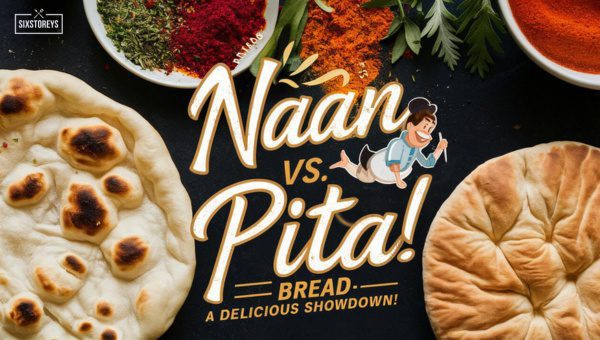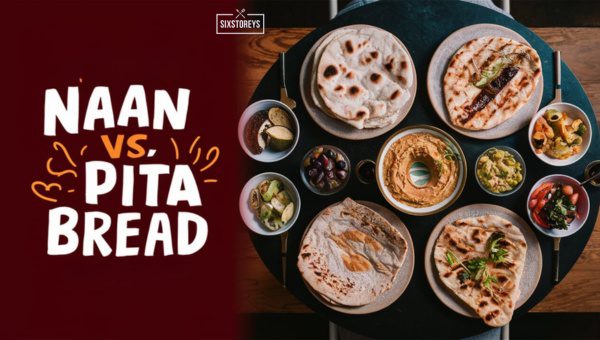Naan vs. Pita Bread: Which Should You Choose?
Bread is a universal comfort food that finds its place in various cultures, and each type has its own unique charm. In the world of flatbreads, naan and pita bread often stand out due to their distinct flavors, textures, and uses. Whether you're scooping up a hearty curry or stuffing a sandwich with fresh veggies and falafel, naan and pita can elevate your culinary experience. With their rich histories and versatile applications, deciding between these two can be a delightful challenge. In this article, we’ll dive into the world of naan vs pita bread, exploring what sets them apart and why each deserves a spot in your kitchen.
Also Read: Best Oat Flour Substitutes

Article Includes
Naan vs. Pita Bread: What Sets Them Apart?
When it comes to flatbreads, naan and pita bread are two top contenders that often spark curiosity and culinary debate. Both hailing from rich cultural backgrounds, they each bring something unique to the table. But what exactly sets these two apart? Let’s break it down.
Origins and Cultural Significance
Naan traces its roots to the Indian subcontinent, making frequent appearances in Indian, Pakistani, and Afghan cuisines. Historically, naan was a luxury item reserved for royalty and the wealthy before it became a staple for the masses.
On the other hand, pita bread finds its origins in the Middle Eastern and Mediterranean regions. This ancient bread has been a key dietary component for centuries, serving as the cornerstone for many iconic dishes like gyros and falafel.
Texture and Flavor Profiles
One of the most noticeable differences between naan and pita bread is their texture. Naan is known for its soft, chewy consistency and its slight charred, crispy edges, often enriched with a buttery or garlicky flavor. This makes it an incredibly indulgent bread that pairs well with rich, savory dishes.
In contrast, pita bread has a lighter, airy texture with a unique pocket inside. This pocket makes it perfect for stuffing with a variety of ingredients. Pita offers a slightly tangy flavor, attributed to the yeast fermentation process, which complements its airy structure.
Ingredients and Preparation
Naan's recipe often includes yogurt, milk, and sometimes eggs, which contribute to its rich texture and flavor. Traditionally, naan is baked in a tandoor oven, which gives it that characteristic charred look and smoky flavor.
On the flip side, pita bread is made from a simpler dough consisting mainly of flour, water, yeast, and salt. It's usually baked at high temperatures in a conventional oven, which causes the dough to puff up and form that classic pocket inside.
Culinary Uses
When it comes to versatility, both breads hold their own. Naan is often used to scoop up curries, kebabs, and other hearty dishes. It’s also delicious when topped with garlic, herbs, or even stuffed with cheese.
Pita bread is extremely versatile in its own right. It’s the go-to choice for sandwiches, wraps, and dipping. Whether you’re enjoying a classic gyro, a falafel wrap, or simply dipping it in hummus, pita bread can adapt to a multitude of meals.
Nutritional Comparison: Which One is Healthier?

When deciding between naan and pita bread, considering their nutritional profiles can help you make an informed choice. Both breads have their own sets of benefits and drawbacks, depending on your dietary needs and preferences.
Basic Nutritional Profiles
Let's break down the basic nutrition per serving for both types of bread:
| Nutritional Content | Naan (1 piece) | Pita Bread (1 piece) |
|---|---|---|
| Calories | 260 | 165 |
| Carbs (g) | 45 | 33 |
| Protein (g) | 7 | 6 |
| Fat (g) | 7 | 1 |
| Fiber (g) | 2 | 2 |
As you can see, naan tends to be higher in calories and fats, primarily due to additional ingredients like yogurt and butter. Pita bread, on the other hand, is generally lighter and lower in fat, making it a slightly better choice if you're watching your calorie intake or following a low-fat diet.
Healthier Options and Substitutions
- Whole Wheat Options: Opting for whole wheat versions of either naan or pita can give you an extra fiber boost, promoting better digestion and keeping you fuller for longer.
- Lower-Fat Variants: For a healthier choice, you can make or purchase versions of naan that use less butter or ghee.
- Reduced Sodium: Some store-bought versions are high in sodium. If you're concerned about salt intake, look for low-sodium options or make your own at home, controlling the amount of salt.
Tips for Making Naan and Pita at Home
There's something deeply satisfying about baking your own bread. Not only do you get to enjoy it fresh out of the oven, but you also have complete control over the ingredients. Here are some basic tips for homemade naan and pita bread.
Making Homemade Naan
Ingredients:
- 2 cups of all-purpose flour
- 1/2 cup of yogurt
- 1/4 cup of warm milk
- 1/4 cup of warm water
- 1 teaspoon of yeast
- 1 teaspoon of sugar
- 1 teaspoon of salt
- Butter or ghee for brushing
Steps:
- Activate Yeast: In a bowl, mix warm water, sugar, and yeast. Let it sit for about 10 minutes until it becomes frothy.
- Mix Ingredients: In a larger bowl, combine flour, salt, yogurt, and milk. Add the yeast mixture and knead until you get a soft dough.
- Rest: Cover the dough with a damp cloth and let it rest for about 2 hours in a warm place.
- Roll and Cook: Divide the dough into small balls, roll them out, and cook on a hot skillet until bubbles form. Flip and cook the other side.
- Brush with Butter: Once cooked, brush with melted butter or ghee for extra flavor.
Making Homemade Pita
Ingredients:
- 2 cups of all-purpose flour
- 3/4 cup of warm water
- 1 teaspoon of yeast
- 1 teaspoon of salt
- 2 teaspoons of olive oil
Steps:
- Activate Yeast: In a bowl, mix warm water and yeast. Let it sit for about 10 minutes until frothy.
- Mix Ingredients: Combine flour, salt, and olive oil in a larger bowl. Add the yeast mixture and knead until smooth.
- Rest: Cover the dough and let it rise for about 1 hour.
- Preheat Oven: Preheat the oven to 475°F (245°C) and place a baking stone or sheet inside to heat up.
- Roll and Bake: Divide the dough into small balls, roll them out, and bake each piece on the hot baking stone for about 3 minutes or until puffed and lightly browned.
Essential Tips
- Consistency Matters: Make sure the dough is well-kneaded and elastic for best results.
- Proper Resting Time: Allowing the dough to rest adequately helps in better puffing and texture.
- High Heat: For pita, ensure your oven is sufficiently hot to achieve that perfect pocket.
Creating homemade versions of naan and pita can be an enjoyable kitchen project that rewards you with fresh, delicious bread made to your exact tastes. Give it a try and see which one you prefer!
Also Read: Does Panera have Gluten Free Bread or Not?
Conclusion
In the duel of naan vs. pita bread, each has its own set of strengths and unique qualities. Whether you prefer the indulgent texture and rich flavor of naan or the light, versatile nature of pita bread, your choice largely depends on the dish you’re preparing and your personal taste. Either way, both breads offer delightful culinary experiences that are worth exploring.
